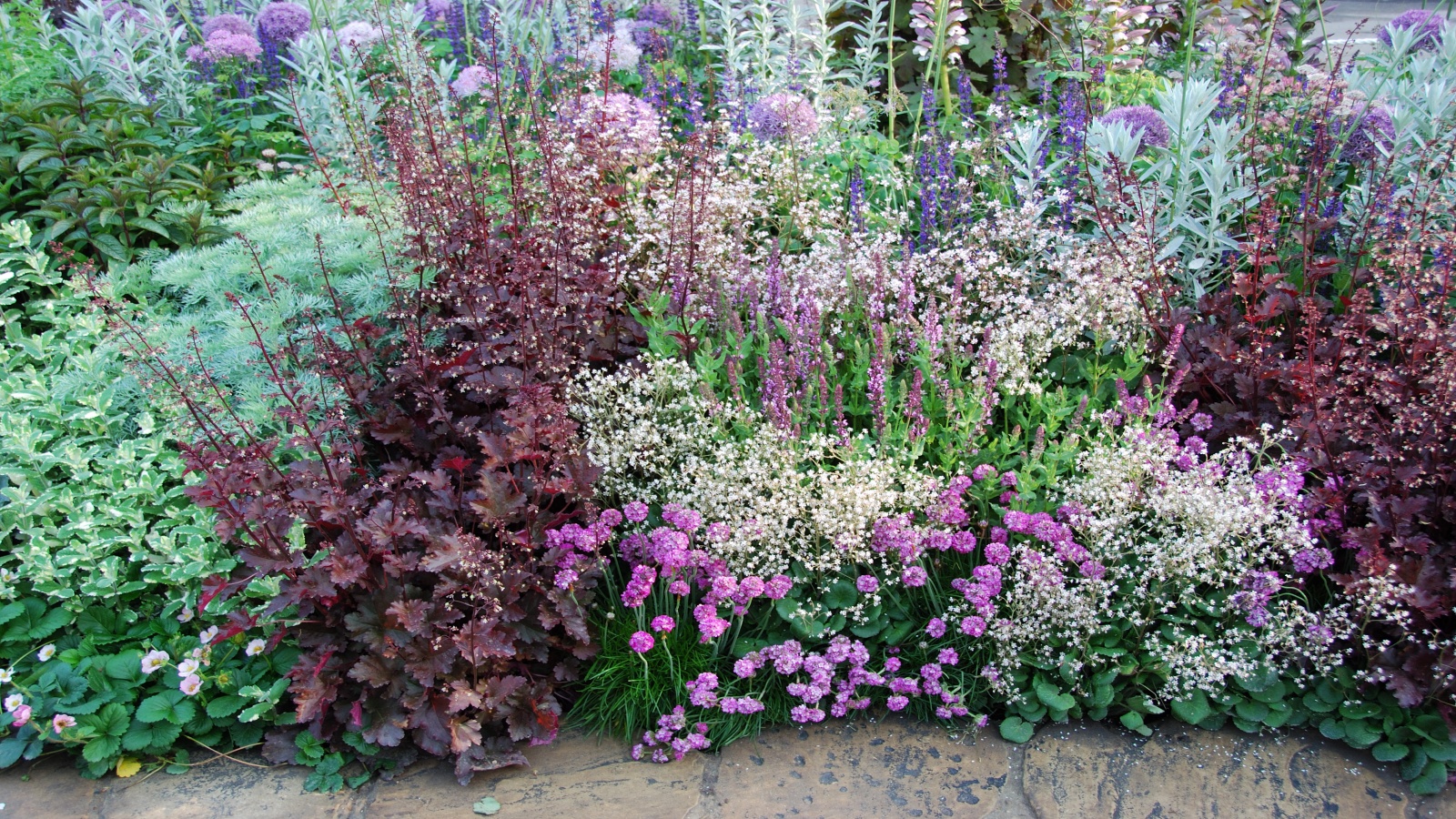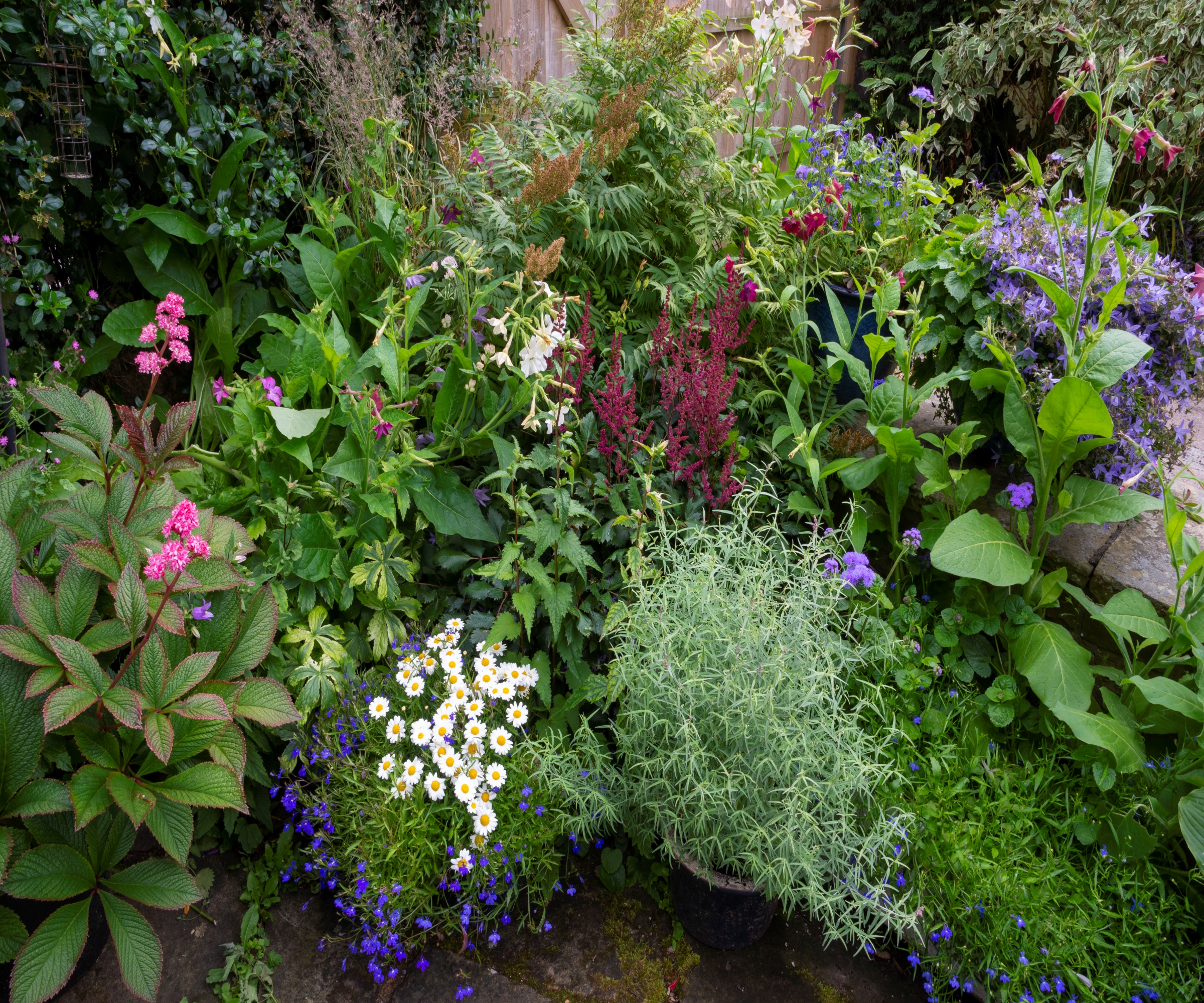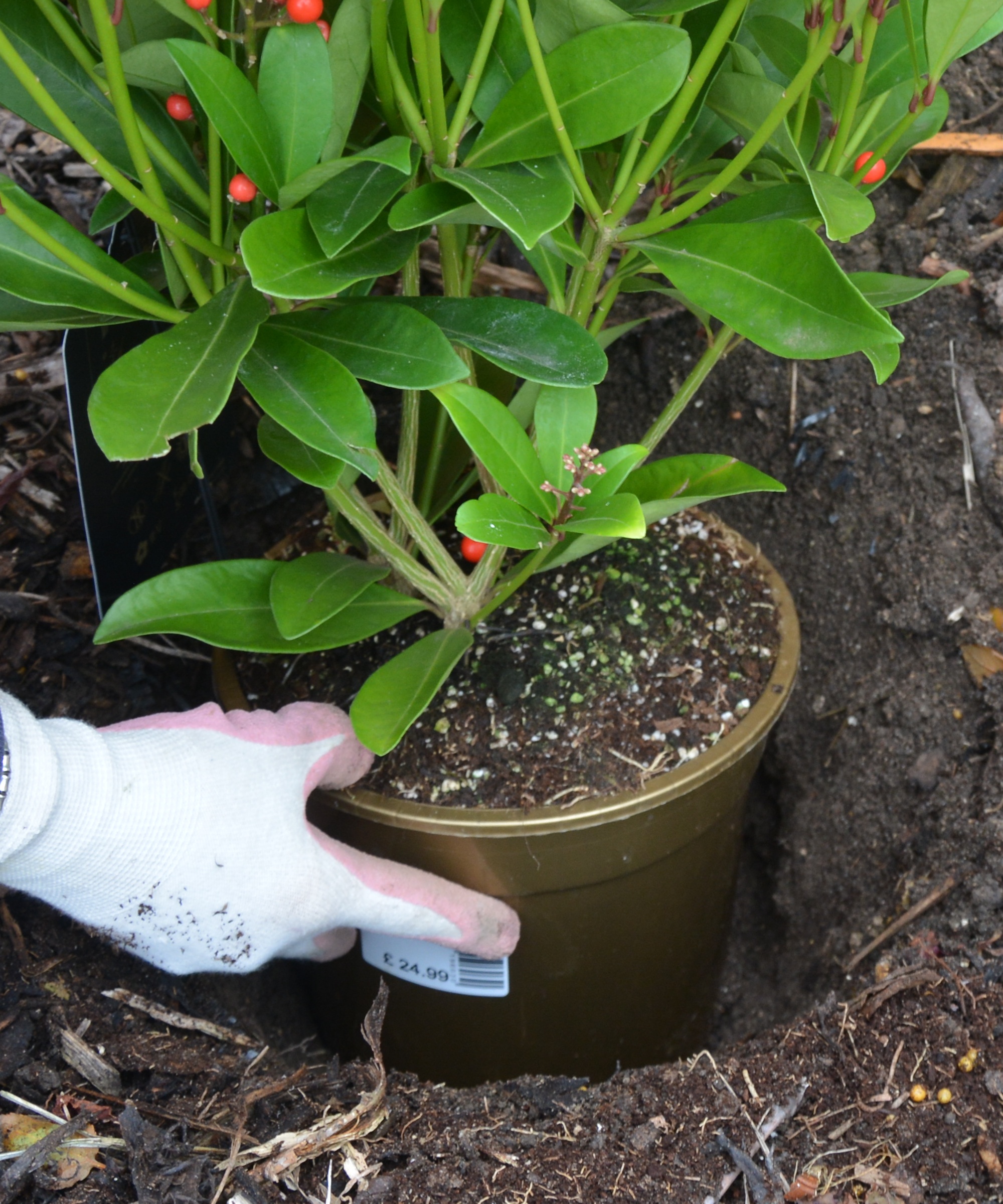How to plant a scented border – for year-round perfume
Step-by-step expert planting advice for creating a scented border to delight your nose


Scent is powerful and evocative, and few things bring more delight to our yards than a fragrant flower bed or border.
Packed with interesting, colourful plants, trees and shrubs that perfume the air through every month of the year, and at all hours of the day and night, they are a joy for our senses.
Moreover, a scented border is actually easy to create, with a wealth of plants to choose from that make their surroundings smell glorious every month of the year. Scented plants also provide essential winter nectar and shelter for bees and other insects that don't fully hibernate.
Although our garden does not have a perfume border as such, we do have several fragrant plants dotted around the garden that scent the air all through the seasons, many of them growing near paths and seating areas where we can get the benefits when we brush against them.
A curry plant with grey-green leaves and bold yellow late-summer flowers perfumes the air all year round, and by the front path we have a Coronilla glauca, also with yellow flowers, which loads the air with the sweetest scent for weeks in mid-winter.
Aromatic herbs are also great additions to a scented border, especially hardy varieties such as rosemary, sage and bay, which also come in handy in the kitchen. Below I take you step by step through planting a scented border and suggest plants that will delight your nose in every season.

Coronilla glauca is an attractive evergreen shrub that flowers in winter with an intense, sweet scent
How to plant a scented border
Scented borders are planted like any other border, in rich, healthy soil that has good drainage. The only difference is that you are aiming to add a selection of flowers that will add perfume to the air throughout the year.
Design expertise in your inbox – from inspiring decorating ideas and beautiful celebrity homes to practical gardening advice and shopping round-ups.
Late winter and early spring is the perfect time to plant a scented border, as long as the ground isn’t waterlogged or frozen.
The soil will be starting to warm up, and every day brings trees, shrubs and plants closer to the moment when they burst back to life.
Get to know your soil

Testing the pH of soil is important when planting a border
It is impossible - or at least, very hard work - to garden successfully without knowing the pH values of your soil.
Most plants will flourish in soil with a neutral pH level, but ericaceous or acid-loving plants such as rhododendrons and many heathers are adapted to growing on acidic soils, and will grow poorly on alkaline soils.
Similarly, plants that thrive in chalky soils such as lilies, foxgloves, lilacs and peonies do best in alkaline or lime-rich soils, and will fail to thrive in acidic soils.
The first thing you need to to is test your soil.
I know it sounds technical and possibly a little scary, but soil pH tests, such as this soil test kit by Garden Tutor on Amazon, are widely available and easy to use. It usually involves taking a small amount of soil and popping it into a phial of prepared chemicals.
Signs that plants are failing to thrive in their soil include slow growth and yellowing leaves, and they rarely reach their full potential if they are unhappy in their soil. But buy the right plants and you will save yourself a lot of time and money.
Choose an appropriate site

Choose a sheltered spot for your scented border so the perfume won't disperse in the wind
When choosing somewhere for your scented border, settle for a sheltered area because even robustly scented shrubs will quickly lose their scent in strong winds.
Pick a site that is easy to manage - I’d advise against a steeply sloping spot - and avoid areas that dry out fast or become waterlogged.
Steer clear of frost pockets, or frost hollows, which are areas of the yard that trap cold air and hold on to snow or frost longer. Very often, frost pockets are low-lying areas that may spend most of the day in shadow.
If you live near the sea, you also need to take salty air and stronger weather into consideration when planning your bed - but there is a wide variety of coastal plants that will fit the bill.
Consider how much sun and shade you get

Shade-loving plants such as hostas prefer not to be in direct bright sunlight
Check the direction your border will be facing to gauge how much light it will get. One way of doing this is to try sun-mapping your yard, taking photos throughout the year to see which areas get the most and least hours of sun a day.
In general terms, south and west-facing areas get the most daylight and will suit sun-loving, Mediterranean garden plants, while borders looking towards the east and north will be better suited to shady plants that prefer not to be subjected to bright light and heat.
Also consider what else is nearby - walls, buildings, and deciduous trees that let in the light in winter but will throw shade when they come into leaf in summer.
Measure your border

Heucheras such as 'Tangerine Wave' have vibrant foliage that they keep all year, providing excellent ground cover
Scented borders can be as large or as small as your yard allows, they can be straight, curved, wavey or circular.
It helps to measure their length and breadth so you can work out how many plants you need to fill the space without overcrowding or leaving too many gaps.
Remember that many herbaceous perennials die back in winter, leaving the soil bare, so you may want to choose ground-cover plants such as sempervivums and heucheras that cover the soil and add interest all year round.
Select your plants

Take time when buying plants and always choose healthy specimens
Plan your scented border before buying any plants, so that you know exactly what you need for where, and avoid expensive mistakes.
This year, as in every year, there are plenty of reputable places where you can buy healthy, flourishing plants and our list of recommended vendors is a good place to start.
At garden centers, always choose healthy-looking specimens, ignoring any that have sad yellowing leaves, are obviously pot-bound with roots growing from the bottom of the container, and have moss growing on the top of their compost, as this indicates they have been hanging around for some time.
Read the labels on each plant to ascertain their eventual width and height and see whether they like sun, shade, or a bit of both.
When buying online, make sure plants come with a guarantee.
Consider the long-term interest of the border in your yard. Scented evergreens such as Osmanthus and sweet box (Sarcococca confusa) will add interest by holding onto their leaves in winter, and filling the coldest months with sweet scent too.
Choose colours that complement each other but don’t be afraid to create eye-catching contrast either.
Don’t limit yourself to plants that throw out scent during the daytime. Many varieties including Nicotiana (tobacco plants) and Phlox are night-scented, making them ideally suited for growing around seating areas.
Position your plants

Place plants on the soil, still in their pots, until you create the arrangement you want
Once you have chosen your plants it helps to set them on the soil, still in their pots, and move them around until you get an arrangement that pleases you.
The general rule of thumb is tallest at the back, grading forwards until ground cover and edging plants are used to fill the front.
If your border runs along a path, 'walkable' scented plants such as chamomile, sweet woodruff and creeping thyme will release their perfume deliciously if crushed by passing footfall.
Planting from containers

Always check the planting hole is deep enough - but not too deep - before adding a plant to your border
Whether you are planting trees, shrubs or perennials that are in containers the basics are the same.
- Once you have decided where you wish them to go, dig a hole as deep as their container and a little wider, because plants often fail to thrive if they are planted deeper, or shallower, than their rootball.
- Fork in some well-rotted compost or manure and some general purpose fertiliser or bone meal, such as this feed by Burpee on Amazon. This will give the roots something to take up once they are settled in and boost plant growth and root spread.
- You may also wish to add some mycorrhizal fungi, like this highly rated Trifecta product on Amazon, beneficial microbes that help with the transference of sugars and water from soil to root, further aiding plant establishment.
- While you are doing this, stand the plant in a bowl of water to saturate the rootball and make it easier to slide from its pot.
- Once it is out, carefully tease open any congested or circling roots and set the plant in the hole, infilling around it with the removed soil and some compost.
- Firm down the soil as you go to knock out air pockets and support the plant, and finish the process by watering generously and mulching over the root area.
- Keep an eye on your plants as they get established, dealing with any pests you spot and watering frequently so the soil stays damp but is not allowed to get sodden.
Planting bare-root

Bare root trees are available in winter, are cheaper to buy than container plants and will grow strongly when the weather warms up
Winter is the best and most economical time to buy trees, shrubs, roses and fruit bushes because this is when bare root varieties are available.
These are young plants, sometimes little more than twigs, that have been sold straight from the soil with their roots wrapped in plastic or burlap.
It is a cheap way of bulk-buying and although the plants look small, once the weather warms up they will soon romp away and fill out. If you buy bare root plants, keep the roots cool and damp until planting, when you should soak them in water for at least 30 minutes beforehand.
Their trunks or stems will have a tide-mark of soil, or a little grafting knob where the rootstock was joined to the variety of tree or shrub, and they should go into the ground at the same depth as the tide mark or with the grafting mark just above the soil surface.
Plant as before and keep them well watered. If the soil is waterlogged or frozen, bare root plants can stay above ground for several days as long as their roots are kept damp and cool and out of sun and wind.
An alternative is to plant them temporarily in large pots or a sheltered area of the yard until their final home becomes available.
What plants to choose?

Lily of the valley provides a sweet scent in late spring
The ideal border contains interest for every month and season of the year and below I have chosen varieties that will bring life, colour and, above all, the best scents to your garden for 12 months of the year.
Plants for spring scent
- Hyacinth
- Narcissus
- Lily of the valley
- Philadephus (mock orange)
- Early roses
- Star jasmine
- Lavender
Plants for summer scent
- Freesia
- Sweet peas
- Sweet woodruff (perfect for ground cover in dry shade)
- Roses
- Lilies
- Night-scented stock
- Phlox
- Nicotiana - another plant that releases scent at night
- Buddleja
- Lemon verbena
- Chocolate cosmos
- Scented leaved pelargoniums
- Fennel

Shrub and dwarf roses such as this variety 'Lambada' are an obvious choice for a scented border and in a sheltered spot will flower from early summer until well into winter
Plants for fall scent
- Cobaea scandens (cup and saucer vine) until the frosts
- Agastache
- Monarda (Bee balm)
- Phlox paniculata
- Salvia
- Heptacodium miconioides (seven son flower tree)
- Plumaria (frangipani)
- Gladiolus murielae
- Mahonia
- Viburnum bodnantense 'Dawn'
Plants for winter scent
- Coronilla glauca
- Sarcoccoca confusa (sweet box)
- Daphne
- Abeliophyllum distichum (white forsythia)
- Rosemary
- Winter honeysuckle
- Heliotrope (Petasites fragrans)
- Witch hazel
- Chimonanthus praecox ‘Luteus’ (wintersweet)
- Viburnum
- Crocus
FAQs
Can I create a scented border with just one variety of plant?
Definitely. Some plants, like lavender and roses, which will also produce red and orange hips for fall and winter colour, can make an attractive scented border by themselves, but I think a mixed bed that offers year-round scent and interest is the ideal.
Is a scented border high-maintenance?
It depends on the varieties you choose. If you have selected plants that will thrive in the soil and situation where you have planted them, they should get on with growing very happily by themselves.
If you live in a hardiness zone where frost and snow is a given, you will have to protect or even move undercover plants that are not fully hardy, which may not always be practical if they are large varieties.
Trees and shrubs will need an annual prune and many perennials will need cutting back in the fall and feeding in spring, but again, if you choose easy-going plants they should be pretty self-sufficient.
Will pests be a problem in a scented border?
No more than in any other area of the yard. In fact, pests may be less of a problem because scented plants will also attract predatory insects that provide natural pest control.
It is also worth remembering that the scent of certain popular varieties such as lavender, salvias and Tagetes (French marigolds) actually repel pests, helping to keep your other plants safe.
Once your scented border is established you can start cutting stems for the vase.
For long-lasting results, cut early in the morning just before the flower buds have started to open. Crush the base of soft stems, and make an inch-long vertical slit in woody stems - this will improve their water uptake.

Ruth is a Contributing Editor for Homes & Gardens, and formerly Gardening Editor of Amateur Gardening magazine. She is horticulturally trained, with a qualification from the Royal Horticultural Society. Her work for Amateur Gardening, the world's oldest weekly gardening publication, involved matching gardening tasks with each season, covering everything from sowing and planting, to pruning, taking cuttings, dealing with pests and diseases and keeping houseplants healthy. She is an expert in ornamental plants and edible crops, and everything she writes about and photographs is in her own garden, that has been a work in progress since her family moved there in 2012.